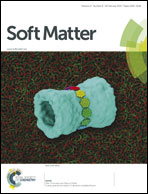Multi stimuli-responsive hydrogel microfibers containing magnetite nanoparticles prepared using microcapillary devices
Abstract
Extensive research efforts have been devoted to the development of hydrogel microfibers for tissue engineering, because the vascular structure is related to the transport of nutrients and oxygen as well as the control of metabolic and mechanical functions in the human body. Even though stimuli-responsive properties would enhance the potential applicability of hydrogel microfibers for artificial tissue architectures, previous studies of their fabrication have not considered changes in the microfibers in response to external stimuli. In this work, we prepared temperature-responsive poly(N-isopropylacrylamide) (PNIPAm) microfibers with controlled shapes and sizes by the in situ photo-polymerization of aqueous monomers loaded in calcium alginate templates generated from microcapillary devices. We found that the shape and size of the hydrogel microfibers could be controlled by adjusting the injection positions of the solutions and varying the diameters of the inner capillary, respectively. We further fabricated light-responsive materials by incorporating photothermal magnetite nanoparticles (MNPs) within the temperature-responsive PNIPAm hydrogel microfibers. Because the MNPs incorporated into the PNIPAm microfibers generated heat upon the absorption of visible light, we could demonstrate volume changes in the microfibers triggered by both visible light irradiation and temperature.


 Please wait while we load your content...
Please wait while we load your content...